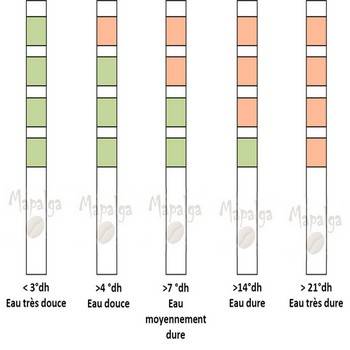What water use for my machine a caf é ?
The water you use in your coffee machine can have important consequences for the quality of your drink and for the reliability of your device.
Depending on the region, the water made available to the tap does not have the same characteristics. Indeed, this water will prove to be soft in Corsica, Auvergne and Brittany, and harder in the rest of France, sometimes with large local disparities.
hard water or fresh water, what does this mean?
The hardness of the water represents the quantity of calcium and magnesium soluble in water and it is directly linked to the nature of the soils crossed.
The hardness of the water is expressed in Hydrotimetric title (TH) or in French degree (° F or ° FH) , which corresponds to a concentration of 10 milligrams of calcium carbonate (CACO3) per liter of water. Beware of the German expression of the hardness which is equivalent to 10 milligrams of calcium oxide (CAD) per liter; This means that a 1 ° FH = 1.78 DH. The difference is size ...
The card below gives an overview of the water hardness on French territory, to have a more precise quotation, you can consult your water supplier, or else to check the value on your invoice, because there are large local differences because catchments can be made in different ways depending on the municipalities.
Meaning of colors:

the harder water, the more it will promote the precipitation of limestone (calcium carbonate). We can avoid the formation of tartar by eliminating calcium by the break of a softener, but the surest is Monitor your coffee machine to do the descaling as often as possible , to avoid degradations of the device.
then I use mineral water in bottle or cycle?
It is a legend to ban your thoughts! The bottled mineral water causes your devices in many cases, because its mineralization gives a very high risk of precipitation in the boiler, which will cause its plug, intervention not covered under the warranty .
Only a few waters may be suitable, they come from very soft water sources from volcanic (Auvergne) or granitic (Brittany) regions. In the example below, we cite waters that could suit your coffee machine without risk of scaling because the calcium/magnesium mineralization does not exceed 30 to 40 mg/liter, beyond the risk of scaling severely increases, the others are therefore to be avoided.

You must be careful to read the mineralization label present on the bottle because certain brands, under the same name, use different sources of regions with strong disparities in terms of hardness.
Finally, let us realize that certain water candies that have filters, do not guarantee the lowering of the hardness of water. These are often filters intended to improve taste and remove certain undesirable substances (heavy metals, pesticides, chlorine, etc.).
In all cases, descaling a coffee machine is the operation necessary to guarantee its longevity and performance, even if you use filters.
In addition, bottled water generates plastic waste that you can do easily.
how to know if my machine is being burst:
Several indices must draw your attention:
1: the water tank of your machine gradually covers itself with a whitish film is the visible sign of the presence of tartar in water.
2: As limestone agrees on resistance and pipes and forms a thick layer which leads to a reduction in water flow, therefore the diffusion of coffee is longer, because the water can no longer flow properly.
3: Likewise limestone, forms an insulating layer on the resistance, and the heating time of your device becomes abnormally long.
4: The coffee has a harsh taste, acid, and the foam does not hold
5: Water flows by drop from the hot water nozzle
6: The coffee is flowing by or more and the pump seems to force
in conclusion
tap water is often the best for your machine Use a test strip to estimate the water hardness. Be careful to use hardness strips well and not acidity which has nothing to do. See here those sold by MAPALGA:
Do not neglect your machine descaling as soon as the symbol planned for the descaling is displayed and monitoring instructions in the user manual.










